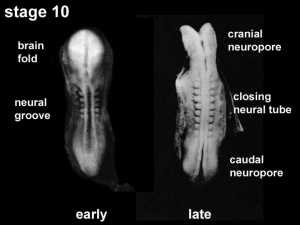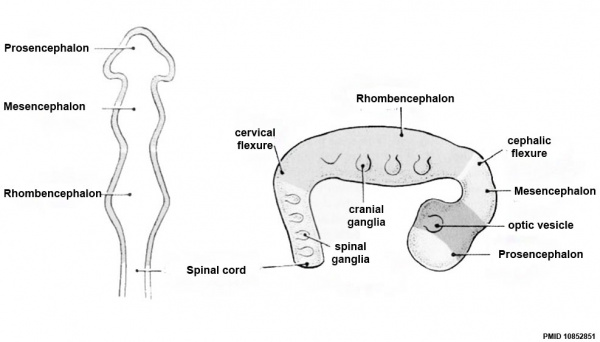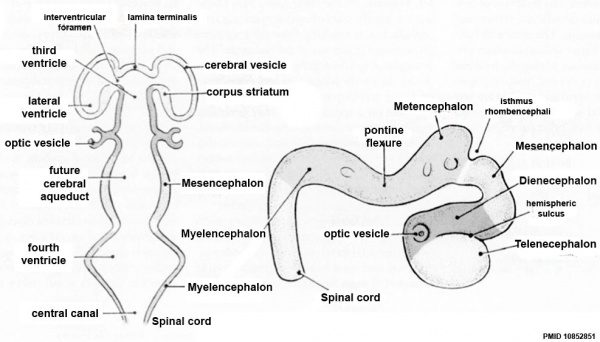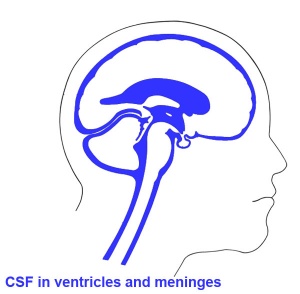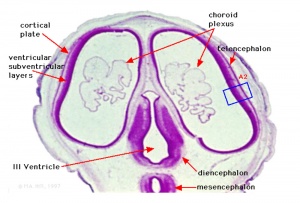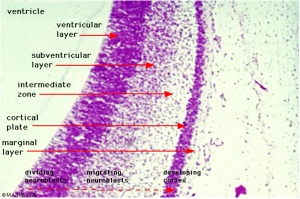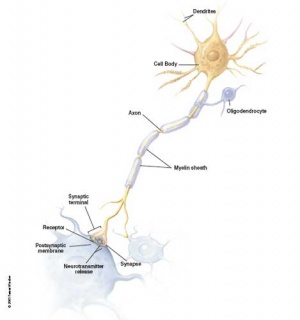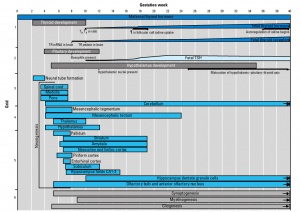Neural System Development
Introduction
Neural development is one of the earliest systems to begin and the last to be completed after birth. This development generates the most complex structure within the embryo and the long time period of development means in utero insult during pregnancy may have consequences to development of the nervous system.
The early central nervous system begins as a simple neural plate that folds to form a groove then tube, open initially at each end. Failure of these opening to close contributes a major class of neural abnormalities (neural tube defects).
Within the neural tube stem cells generate the 2 major classes of cells that make the majority of the nervous system : neurons and glia. Both these classes of cells differentiate into many different types generated with highly specialized functions and shapes. This section covers the establishment of neural populations, the inductive influences of surrounding tissues and the sequential generation of neurons establishing the layered structure seen in the brain and spinal cord.
- Neural development beginnings quite early, therefore also look at notes covering Week 3- neural tube and Week 4-early nervous system.
- Development of the neural crest and sensory systems (hearing/vision/smell) are only introduced in these notes and are covered in other notes sections.
| Neural Crest Development | Sensory System Development | original Neural page
Some Recent Findings
|
Objectives
- Understand early neural development.
- Understand the formation of spinal cord.
- Understand the formation of the brain; grey and white matter from the neural tube.
- Understand the role of migration of neurons during neural development.
- To know the main derivatives of the brain vesicles and their walls.
- To know how the nervous system is modelled, cell death etc.
- To understand the contribution of the neural crest.
- Understand the developmental basis of certain congenital anomalies of the nervous system, including hydrocephalus, spina bifida, anencephaly and encephalocele.
Reading
- Human Embryology (3rd ed.) Chapter 5 p107-125
- The Developing Human: Clinically Oriented Embryology (6th ed.) Moore and Persaud Chapter 18 p451-489
- Essentials of Human Embryology Larson Chapter 5 p69-79
- Before We Are Born (5th ed.) Moore and Persaud Chapter 19 p423-458
- Human Embryology, Fitzgerald and Fitzgerald
- History of Science- Brain and Mind, Brain Structure, Camille Golgi, S. Ramon y Cajal
UNSW Embryology Links
- Ectoderm Lectures Early Neural Lecture 2010 | Early Neural Lecture 2009 | Neural Lecture 5 2008
- Ectoderm Movies Neural Animations | Notochord | Stage 13 Embryo | Stage 22 Neural |
- Ectoderm Notes Timeline - Embryonic Week 3 | Carnegie Stages | Neural System - Abnormalities | original Neural Notes | original Neural Crest Notes
- Animal Neural Development - A number of different animal models of neural development, both normal and abnormal, have been established. Mouse | Pig | Rabbit
Human Early Neural Development
The stages below refer to specific Carneigie stages of development. Data and text modified from O'Rahilly and Müller 1994.[3]
- stage 8 - (about 18 postovulatory days) neural groove and folds are first seen
- stage 9 - the three main divisions of the brain, which are not cerebral vesicles, can be distinguished while the neural groove is still completely open.
- stage 10 - (two days later) neural folds begin to fuse near the junction between brain and spinal cord, when neural crest cells are arising mainly from the neural ectoderm
- stage 11 - (about 24 days) the rostral (or cephalic) neuropore closes within a few hours; closure is bidirectional, it takes place from the dorsal and terminal lips and may occur in several areas simultaneously. The two lips, however, behave differently.
- stage 12 - (about 26 days) The caudal neuropore takes a day to close
- the level of final closure is approximately at future somitic pair 31
- corresponds to the level of sacral vertebra 2
- stage 13 - (4 weeks) the neural tube is normally completely closed
Secondary neurulation begins at stage 12 - is the differentiation of the caudal part of the neural tube from the caudal eminence (or end-bud) without the intermediate phase of a neural plate.
Development Overview
Neuralation begins at the trilaminar embryo with formation of the notochord and somites, both of which underly the ectoderm and do not contribute to the nervous system, but are involved with patterning its initial formation. The central portion of the ectoderm then forms the neural plate that folds to form the neural tube, that will eventually form the entire central nervous system.
- Early developmental sequence: Epiblast - Ectoderm - Neural Plate - Neural groove and Neural Crest - Neural Tube and Neural Crest
| Neural Tube | Primary Vesicles | Secondary Vesicles | Adult Structures |
|---|---|---|---|
| week 3 | week 4 | week 5 | adult |
| prosencephalon (forebrain) | telencephalon | Rhinencephalon, Amygdala, hippocampus, cerebrum (cortex), hypothalamus, pituitary | Basal Ganglia, lateral ventricles | |
| diencephalon | epithalamus, thalamus, Subthalamus, pineal, posterior commissure, pretectum, third ventricle | ||
| mesencephalon (midbrain) | mesencephalon | tectum, Cerebral peduncle, cerebral aqueduct, pons | |
| rhombencephalon (hindbrain) | metencephalon | cerebellum | |
| myelencephalon | medulla oblongata, isthmus | ||
| spinal cord, pyramidal decussation, central canal | |||
Notochord
Does not contribute to the final nervous system, but is critical to patterning the development.
- forms initially as the Axial Process, a hollow tube which extends from the primitive pit , cranially to the oral membrane
- the axial process then allow transient communication between the amnion and the yolk sac through the neuroenteric canal.
- the axial process then merges with the Endodermal layer to form the Notochordal Plate.
- the notochordal plate then rises back into the Mesodermal layer as a solid column of cells which is the Notochord.
Ectoderm
Two main parts with different morphology
- columnar - midline neural plate forming neural tube and neural crest
- cuboidal - lateral surface ectoderm forming epidermis and sensory placodes
- epidermis of skin, hair, glands, anterior pituitary, teeth enamel
- sensory placodes
Neural Plate
The neural plate forms above the notochord and paraxial mesoderm and extends from the buccopharyngeal membrane to primitive node. The cells are described as neuroectodermal and form initially two regions along the head to tail axis: a cranial broad plate region (brain plate) and caudally a narrower plate region (spinal cord).
Neural Determination
Neuronal populations are thought to be specified before the plate folds by signals from underlying notochord and mesoderm, as well as signals spread laterally through teh plate.
- secrete noggin, chordin,follistatin
- all factors bind BMP-4 an inhibitor of neuralation bone morphogenic protein acts through membrane receptor
Lateral Inhibition
- generates at spinal cord level 3 strips of cells
- expression of delta inhibits nearby cells, which express notch receptor, from becoming neurons
- Delta-Notch- generates "neural strips"
Neural Groove
- forms in the midline of the neural plate (day 18-19)
- either side of which are the neural folds
- continues to deepen until about week 4
- neural folds begins to fuse
- at 4th somite level
Neural Tube
- fusion of neural groove extends rostrally and caudally
- begins at level of 4th somite, "zips up" neural groove
- leaves 2 openings at either end- Neuropores
- forms the brain and spinal cord
- Secondary Neuralation - caudal end of neural tube formed by secondary neuralation, develops from primitive streak region, solid cord canalized by extension of neural canal. mesodermal caudal eminence
Neuropores
- cranial (anterior) neuropore closes before caudal (posterior)
- failure to close - Neural Tube Defects (NTD), severity dependent upon level, spina bifida anancephaly (More? [neuron2.htm Neural Abnormalities])
- found that supplementation of maternal diet with folate reduces incidence of NTDs
- A randomised controlled trial conducted by the Medical Research Council of the United Kingdom demonstrated a 72% reduction in risk of recurrence by periconceptional (ie before and after conception) folic acid supplementation (4mg daily).
- Women who have one infant with a neural tube defect have a significantly increased risk of recurrence (40-50 per thousand compared with 2 per thousand for all births)
Neural Crest
(More? Neural Crest Development)
- a population of cells at the edge of the neural plate that lie dorsally when the neural tube fuses
- dorsal to the neural tube, as a pair of streaks
- cells migrate throughout the embryo
- studied by quail-chick chimeras - transplanted quail cells have obvious nucleoli compared with chicken Neural Crest Derivitives
- pluripotential, forms many different types of cells: dorsal root ganglia (neurons, sheath cells, glia), autonomic ganglia, adrenal medulla, pia-arachnoid sheath, skin melanocytes, connective tissue of cardiac outflow, thyroid parafollicular cells, craniofacial skeleton and teeth odontoblasts.
Early Brain Structure
Primary Vesicles
- rostral neural tube forms 3 primary brain vesicles (week 4)
- 3 primary vesicles: prosencephalon (forebrain), mesencephalon (midbrain), rhombencephalon (hindbrain)
Secondary Vesicles
From the 3 primary vesicles developing to form 5 secondary vesicles
- prosencephalon- telencephalon (endbrain, forms cerebral hemispheres), diencephalon (betweenbrain, forms optic outgrowth)
- mesencephalon
- rhombencephalon- metencephalon (behindbrain), myelencephalon (medullabrain)
Ventricles
- cavity within tube will form the contiguious space of the ventricules of the brain and central canal of spinal cord
- this space is filled initially with amniotic fluid, later with CerebroSpinal Fluid (CSF)
- CSF is secreted by a modified vascular structure, the chorioid plexus, lying within the ventricles
(More? Neural - Ventricular System Development)
Brain Flexures
Rapid growth folds the neural tube forming 3 brain flexures
- cervical flexure - between brain stem and spinal cord
- midbrain flexure - pushes mesencephalon upwards
- pontine flexure - generates 4th ventricle
Neural Layers
- neural stem cells lie in the layer closest to the ventricular space, the ventricular layer
- this layer generates both neuroblasts and glioblasts
Neuroblasts - neurons arise first as neuroblasts and migrate along radial gial, their migration stops at cortical plate. Glioblasts - glia arise later as glioblasts
Both neurons and glia undergo a complex process of growth, differentiation and interaction over a long developmental time period.
Spinal Cord Axes
- Experimental manipulation of interactions.
- Initial experiments looked at how isolated tissues may influence the development of the spinal cord.
- Repositionining of specific tissues both in vivo and in vitro
- specific markers of or alteration of differentiation.
Notocord Induction
- Ventral- Sonic Hedgehog
- notochord secretes sonic hedgehog
- Gene expression studies (ISH) showed shh gene expression occured in a subset of inducing tissues
- has a patterning role elsewhere (limb, sclerotome, lung)
- 2 signaling activities acting (locally and at a distance) Ventral- Sonic Hedgehog
- Binds to cell surface receptor patched
- without shh, patched (Ptc) binds smoothened (Smo)
- with shh shh-Ptc releases Smo activating G protein pathway
Early Development and Neural Derivatives
- bilaminar embryo- hyoblast
- trilaminar embryo then ectoderm layer, neural plate, neural groove, neural tube and neural crest
- cranial expansion of neural tube- central nervous system
- caudal remainder of neural tube- spinal cord
- neural crest
- dorsal root ganglia
- parasympathetic / sympathetic ganglia.
- ectodermal placodes- components of the special senses: otic placode (otocyst), nasal placode, lens placode
Links: Placodes
Neural tube and Genes: neural specification- Notch/Delta, patched receptor. Border- fibroblast growth factor (fgf), BMP (BMP4, msx1) Rostral border- Dlx5
Neural tube patterning
- segmented along its length- Hox/Lim gene expression
- ventral identity- sonic hedgehog, BMP7/chordin interaction
- dorsal identity- dorsalin
Fetal Development
For more details see Neural System - Fetal
Fetal - Second Trimester
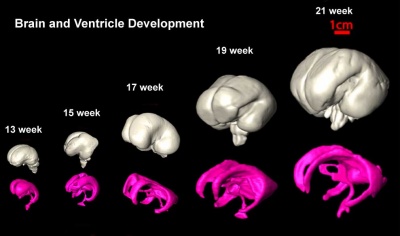
|

|
| Brain and Ventricular Development[4] | Brain Fissure Development[4] |
Third Trimester
Three-dimensional magnetic resonance imaging and image-processing algorithms have been used to quantitate between 29-41 weeks volumes of: total brain, cerebral gray matter, unmyelinated white matter, myelinated, and cerebrospinal fluid (grey matter- mainly neuronal cell bodies; white matter- mainly neural processes and glia). A study of 78 premature and mature newborns showed that total brain tissue volume increased linearly over this period at a rate of 22 ml/week. Total grey matter also showed a linear increase in relative intracranial volume of approximately 1.4% or 15 ml/week. The rapid increase in total grey matter is mainly due to a fourfold increase in cortical grey matter. Quantification of extracerebral and intraventricular CSF was found to change only minimally.[5]
Thyroid System and Neural Development
Timeline of human thyroid system and brain development from conception to birth.[6] (Estimation of neurogenesis adapted from Bayer et al.[7])
Gliogenesis and Myelination
Glial cells have many different types and roles in central and peripheral neural development, though they are typically described as "supportive", and have the same early embryonic origins as neurons. (More? [neuron7.htm Gliogenesis and Myelination])
Early in neural development a special type of developmental glia, radial glia, provide pathway for developing neuron (neuroblasts) migration out from the proliferating ventricular layer and are involved in the subsequent lamination and columnar organization of the central nervous system.
Types of glia: radial glia, astroglia, oligodendroglia, microglia and Schwann cells.
Gene Diseases - Sonic Hedgehog
SHH Human mutation- holoprosencephaly 3
- characteristic facies of the severe form of HPE which included a single fused eye (cyclopia) and a nose-like structure (proboscis) above the eye
- Downstream targets of Sonic hedgehog signalling: transcription factors like Gli3 (responsible for Greigs polycephalosyndactyly in humans), d Hoxd13 (responsible for polysyndactyly)
References
- ↑ <pubmed>20558153</pubmed>
- ↑ <pubmed>19420217</pubmed>
- ↑ <pubmed>8005032</pubmed>
- ↑ 4.0 4.1 <pubmed>19339620</pubmed>| PMC2721010 | J Neurosci.
- ↑ <pubmed>9485064</pubmed>
- ↑ <pubmed>12060827</pubmed>
- ↑ <pubmed>8361683</pubmed>
Journals
- Neural Development Browse contents
- Developmental Brain Research Content Listing
- Neural Development Welcome to Neural Development | Pubmed Central Volume 1 2006 | Pubmed Central Volume 2 2007 |
- International Journal for Developmental Neuroscience Official Journal of the International Society for Developmental Neuroscience |
- Developmental Neuroscience Journal Homepage | Hippocampal Development | Vol. 29, No. 3, 2007 |
- Neuroscience Official journal of The International Brain Research Organisation (IBRO)
- Neuron Neuroscience journal published by Cell press
Online Textbooks
Developmental Biology (6th ed) Gilbert, Scott F. Sunderland (MA): Sinauer Associates, Inc.; c2000. Formation of the Neural Tube | Differentiation of the Neural Tube | Tissue Architecture of the Central Nervous System | Neuronal Types | Snapshot Summary: Central Nervous System and Epidermis
Neuroscience Purves, Dale; Augustine, George J.; Fitzpatrick, David; Katz, Lawrence C.; LaMantia, Anthony-Samuel; McNamara, James O.; Williams, S. Mark. Sunderland (MA): Sinauer Associates, Inc. ; c2001 Early Brain Development | Construction of Neural Circuits | Modification of Brain Circuits as a Result of Experience
Molecular Biology of the Cell (4th Edn) Alberts, Bruce; Johnson, Alexander; Lewis, Julian; Raff, Martin; Roberts, Keith; Walter, Peter. New York: Garland Publishing; 2002. Neural Development | The three phases of neural development
Health Services/Technology Assessment Text (HSTAT) Bethesda (MD): National Library of Medicine (US), 2003 Oct. Developmental Disorders Associated with Failure to Thrive
Search NLM Online Textbooks- "neural development" : Developmental Biology | The Cell- A molecular Approach | Molecular Biology of the Cell | Endocrinology
Reviews
<pubmed>16314867</pubmed> <pubmed>19206138</pubmed>
Articles
<pubmed>18230116</pubmed>
Search PubMed
Search Pubmed: Neural System Development | Neural Development | Neural Tube Development | Spinal Cord Development
| System Links: Introduction | Cardiovascular | Coelomic Cavity | Endocrine | Gastrointestinal Tract | Genital | Head | Immune | Integumentary | Musculoskeletal | Neural | Neural Crest | Placenta | Renal | Respiratory | Sensory | Birth |
Glossary Links
- Glossary: A | B | C | D | E | F | G | H | I | J | K | L | M | N | O | P | Q | R | S | T | U | V | W | X | Y | Z | Numbers | Symbols | Term Link
Cite this page: Hill, M.A. (2024, April 30) Embryology Neural System Development. Retrieved from https://embryology.med.unsw.edu.au/embryology/index.php/Neural_System_Development
- © Dr Mark Hill 2024, UNSW Embryology ISBN: 978 0 7334 2609 4 - UNSW CRICOS Provider Code No. 00098G

